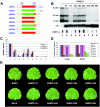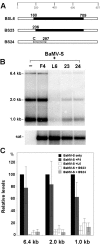Crucial role of the 5' conserved structure of bamboo mosaic virus satellite RNA in downregulation of helper viral RNA replication
- PMID: 16474162
- PMCID: PMC1395367
- DOI: 10.1128/JVI.80.5.2566-2574.2006
Crucial role of the 5' conserved structure of bamboo mosaic virus satellite RNA in downregulation of helper viral RNA replication
Erratum in
- J Virol. 2006 Apr;80(8):4204. Annamali, Padmanaban [corrected to Annamalai, Padmanaban]
Abstract
Satellite RNA of Bamboo mosaic virus (satBaMV), a single-stranded mRNA type satellite encoding a protein of 20 kDa (P20), depends on the helper BaMV for replication and encapsidation. Two satBaMV isolates, BSF4 and BSL6, exhibit distinctly differential phenotypes in Nicotiana benthamiana plants when coinoculated with BaMV RNA. BSL6 significantly reduces BaMV RNA replication and suppresses the BaMV-induced symptoms, whereas BSF4 does not. By studies with chimeric satBaMVs generated by exchanging the components between BSF4 and BSL6, the genetic determinants responsible for the downregulation of BaMV replication and symptom expression were mapped at the 5' untranslated region (UTR) of BSL6. The 5' UTR of BSL6 alone is sufficient to diminish BaMV RNA replication when the 5' UTR is inserted in cis into the BaMV expression vector or when coinoculation with mutants that block the synthesis of P20 protein takes place. Further, the 5' UTR of natural satBaMV isolates contains one hypervariable (HV) region which folds into a conserved apical hairpin stem-loop (AHSL) structure (W. B. Yeh, Y. H. Hsu, H. C. Chen, and N. S. Lin, Virology 330:105-115, 2004). Interchanges of AHSL segment of HV regions between BSF4 and BSL6 led to the ability of chimeric satBaMV to interfere with BaMV replication and symptom expression. The conserved secondary structure within the HV region is a potent determinant of the downregulation of helper virus replication.
Figures





Similar articles
-
Downregulation of Bamboo mosaic virus replication requires the 5' apical hairpin stem loop structure and sequence of satellite RNA.Virology. 2007 Sep 1;365(2):271-84. doi: 10.1016/j.virol.2007.03.050. Epub 2007 May 4. Virology. 2007. PMID: 17482233
-
A conserved secondary structure in the hypervariable region at the 5' end of Bamboo mosaic virus satellite RNA is functionally interchangeable.Virology. 2004 Dec 5;330(1):105-15. doi: 10.1016/j.virol.2004.09.025. Virology. 2004. PMID: 15527838
-
Structural and functional analyses of the 3' untranslated region of Bamboo mosaic virus satellite RNA.Virology. 2009 Mar 30;386(1):139-53. doi: 10.1016/j.virol.2009.01.019. Epub 2009 Feb 7. Virology. 2009. PMID: 19201437
-
Interfering Satellite RNAs of Bamboo mosaic virus.Front Microbiol. 2017 May 4;8:787. doi: 10.3389/fmicb.2017.00787. eCollection 2017. Front Microbiol. 2017. PMID: 28522996 Free PMC article. Review.
-
[Subviral molecules of RNA associated with plant ss(+)RNA viruses].Postepy Biochem. 2006;52(2):212-21. Postepy Biochem. 2006. PMID: 17078511 Review. Polish.
Cited by
-
Short 5' Untranslated Region Enables Optimal Translation of Plant Virus Tricistronic RNA via Leaky Scanning.J Virol. 2022 Apr 13;96(7):e0214421. doi: 10.1128/jvi.02144-21. Epub 2022 Mar 9. J Virol. 2022. PMID: 35262378 Free PMC article.
-
Biologically-supported structural model for a viral satellite RNA.Nucleic Acids Res. 2015 Nov 16;43(20):9965-77. doi: 10.1093/nar/gkv917. Epub 2015 Sep 17. Nucleic Acids Res. 2015. PMID: 26384416 Free PMC article.
-
The conserved 5' apical hairpin stem loops of bamboo mosaic virus and its satellite RNA contribute to replication competence.Nucleic Acids Res. 2012 May;40(10):4641-52. doi: 10.1093/nar/gks030. Epub 2012 Jan 25. Nucleic Acids Res. 2012. PMID: 22278884 Free PMC article.
-
Distribution of mutational fitness effects and of epistasis in the 5' untranslated region of a plant RNA virus.BMC Evol Biol. 2015 Dec 7;15:274. doi: 10.1186/s12862-015-0555-2. BMC Evol Biol. 2015. PMID: 26643527 Free PMC article.
-
Molecular interactions of plant viral satellites.Virus Genes. 2021 Feb;57(1):1-22. doi: 10.1007/s11262-020-01806-9. Epub 2020 Nov 23. Virus Genes. 2021. PMID: 33226576 Review.
References
-
- Annamalai, P., Y. H. Hsu, Y. P. Liu, C. H. Tsai, and N. S. Lin. 2003. Structural and mutational analyses of cis-acting sequences in the 5′-untranslated region of satellite RNA of bamboo mosaic potexvirus. Virology 311:229-239. - PubMed
-
- Baulcombe, D. C., G. R. Saunders, M. W. Bevan, M. A. Mayo, and B. D. Harrison. 1986. Expression of biologically active viral satellite RNA from the nuclear genome of transformed plants. Nature 321:446-449.
-
- Chang, B. Y., N. S. Lin, D. Y. Liou, J. P. Chen, G. G. Liou, and Y. H. Hsu. 1997. Subcellular localization of the 28 kDa protein of the triple-gene-block of bamboo mosaic potexvirus. J. Gen. Virol. 78:1175-1179. - PubMed
Publication types
MeSH terms
Substances
LinkOut - more resources
Full Text Sources
Miscellaneous

